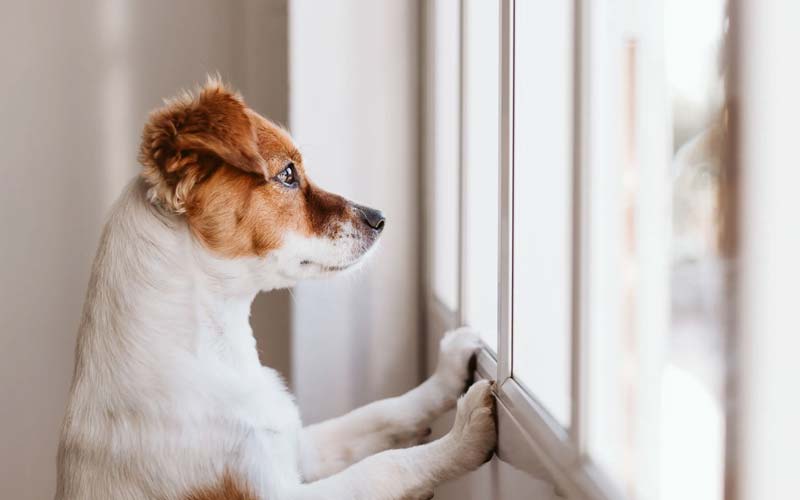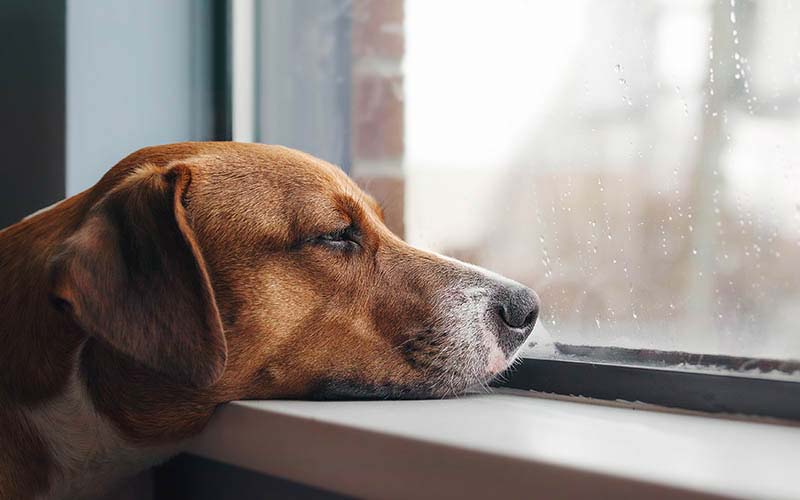Leaving your dog home alone is a common concern for many pet owners, especially those with busy schedules or frequent obligations outside the home. While it’s normal for dogs to spend some time by themselves, knowing how long is too long and how to prepare them can make a significant difference in their well-being. Age, breed, training, and temperament all play a role in determining how comfortable your dog will be when left alone. In this guide, we’ll explore key factors to consider before leaving your dog home, provide practical tips to ease the process, and discuss alternatives for ensuring your pet’s happiness and safety while you’re away.

1. Factors to Consider Before Leaving Your Dog Alone
1.1 Age and Developmental Stage
A dog’s age plays a crucial role in determining how well they can handle being left alone. Puppies, for instance, have limited bladder control and a higher need for socialization, meaning they should not be left alone for extended periods. Generally, puppies can hold their bladder for one hour per month of age, so a three-month-old puppy can only be left alone for about three hours at a time. Leaving them for longer may result in accidents and increased stress.
Adult dogs, on the other hand, have better bladder control and more established routines, making it easier for them to spend 4-6 hours alone. However, even fully-grown dogs should not be left alone for more than 8 hours regularly, as they may become bored or anxious, leading to destructive behavior. Senior dogs, much like puppies, may also need more frequent bathroom breaks and attention due to age-related health issues like arthritis or incontinence.
1.2 Dog Breed and Temperament
Breed and temperament are important factors when evaluating how well a dog will tolerate being left alone. Independent breeds, such as Basset Hounds and Bulldogs, are typically more content spending time alone compared to companion breeds like Chihuahuas or Pomeranians, who crave constant interaction. Social breeds, such as Golden Retrievers and Labrador Retrievers, may struggle more when left alone for long hours due to their highly affectionate and people-oriented nature.
Similarly, temperament varies within breeds. Some dogs, regardless of breed, naturally exhibit more independence and are less prone to anxiety, while others may become stressed and exhibit signs of separation anxiety if left alone too often.
1.3 Training and Past Experiences
Training is a key element in preparing a dog to be alone. Crate training can provide dogs with a safe, secure environment where they feel comfortable resting while their owners are away. Gradual desensitization to being alone also helps reduce stress. Starting with short absences and gradually increasing the time spent away can help build a dog’s tolerance.
Additionally, a dog’s past experiences with being left alone can shape their behavior. Dogs that have experienced frequent or extended periods of isolation without proper training may develop separation anxiety or destructive behaviors. In contrast, dogs who have been properly acclimated to alone time often handle it with minimal stress.

2. How Long Is Too Long? Guidelines for Leaving Dogs Alone
2.1 General Time Limits
The amount of time a dog can comfortably be left alone varies depending on factors such as age, training, and temperament. For most adult dogs, a general rule is that they can handle being left alone for 4-6 hours at a time. During this period, they typically have enough bladder control, and with proper preparation (exercise and mental stimulation), they can remain content and relaxed.
However, leaving a dog alone for extended periods, especially beyond 8 hours, can result in negative consequences. Without enough stimulation, dogs may become bored, anxious, or stressed, leading to destructive behaviors such as chewing furniture, barking excessively, or having accidents indoors. Prolonged loneliness can also trigger separation anxiety in some dogs, causing emotional distress each time they are left alone.
2.2 Special Considerations for Puppies and Senior Dogs
Puppies require significantly more attention and care compared to adult dogs. Their smaller bladders mean they need bathroom breaks more frequently—about every 2-3 hours, depending on their age. In addition to bathroom needs, puppies are in a critical stage of socialization and development, and spending too much time alone can hinder their growth. For this reason, puppies should ideally not be left alone for more than 2-3 hours at a time.
Senior dogs, while generally more calm, may also have specific needs that limit their ability to be left alone for extended periods. Age-related issues such as arthritis, incontinence, or hearing loss can increase their discomfort when left alone. Older dogs may need more frequent bathroom breaks, shorter periods of isolation, and a comfortable, quiet space to rest. Providing extra care ensures their physical and emotional well-being is protected while you’re away.

3. Preparing Your Dog for Alone Time
3.1 Physical and Mental Stimulation
To ensure your dog is content and well-behaved when left alone, it’s essential to provide ample physical and mental stimulation before you head out. Start by incorporating regular exercise into your dog’s routine. A vigorous walk, play session in the yard, or an interactive game can help expend excess energy and reduce restlessness.
Mental stimulation is equally important. Puzzle toys, which require problem-solving to access treats, and chew toys can keep your dog occupied and mentally engaged. Interactive feeders, which dispense food as your dog plays with them, are another excellent way to combine mealtime with mental challenge. Engaging toys not only prevent boredom but also help alleviate separation anxiety by distracting your dog from your absence.
3.2 Creating a Comfortable and Safe Space
Designating a specific area or crate for your dog can create a sense of security and comfort while you’re away. A well-chosen crate or a cozy, enclosed space acts as a safe retreat where your dog can relax and feel protected. Ensure this space is equipped with a comfortable bed and access to water.
To enhance the comfort of the area, consider adding calming elements such as soft bedding, familiar toys, and perhaps a piece of your clothing to provide a reassuring scent. Playing calming music or white noise can also help soothe your dog and mask outside noises that may be unsettling. Creating a pleasant and secure environment will help your dog feel less anxious and more at ease when left alone.
3.3 Gradual Alone Time Training
Introducing your dog to being alone should be a gradual process to build tolerance and prevent anxiety. Start by leaving your dog alone for very short periods and gradually increase the duration as they become more comfortable. Begin with just a few minutes and slowly extend the time as your dog adjusts.
Incorporate positive reinforcement during this training phase. Reward your dog with treats and praise when they remain calm during your departures and arrivals. Avoid making a fuss when you leave or return, as this can create undue stress. The goal is to make being alone a normal and non-threatening experience. With patience and consistency, your dog will learn to associate your absence with positive experiences rather than anxiety.

4. How to Monitor and Care for Your Dog When You’re Not Home
4.1 Using Technology to Check In
Advancements in technology offer valuable tools for monitoring your dog while you’re away. Dog cameras or monitors allow you to keep an eye on your pet in real-time through your smartphone or computer. These devices can provide peace of mind by showing you how your dog is behaving and whether they are adjusting well to your absence. Some models come equipped with two-way audio, so you can even talk to your dog or hear if they’re barking excessively.
Additionally, interactive devices such as treat dispensers can be programmed to reward your dog at intervals during the day. These gadgets can be controlled remotely via apps, allowing you to engage with your dog and provide positive reinforcement even when you’re not home. Using these technologies helps ensure that your dog is not only monitored but also feels a connection with you throughout the day.
4.2 Hiring Help: Dog Walkers and Pet Sitters
If you anticipate being away for extended periods, hiring a dog walker or pet sitter can be a practical solution. Dog walkers can provide much-needed exercise and bathroom breaks, while pet sitters can offer companionship, feeding, and other care services. This can help reduce your dog’s anxiety and prevent boredom by ensuring they receive personal attention and care.
When selecting a dog walker or pet sitter, it’s crucial to find a reliable and trustworthy professional. Start by asking for recommendations from friends, family, or your veterinarian. Conduct interviews and check references to ensure the candidate has experience and a good reputation. It’s also helpful to arrange a trial run to observe how your dog interacts with the new caregiver and to address any specific needs or preferences your dog may have. Proper vetting and communication with your chosen pet care professional will help ensure that your dog remains happy and well-cared-for in your absence.

5. Signs Your Dog Isn’t Coping Well With Alone Time
Recognizing when your dog is struggling with being alone is crucial for their well-being and your peace of mind. Common signs of separation anxiety include:
- Excessive Barking or Howling: Persistent vocalization when you leave or while you are away is a strong indicator of distress. Dogs with separation anxiety often bark or howl excessively to express their discomfort.
- Destructive Behavior: Chewing furniture, scratching doors, or tearing up household items can be a result of anxiety. This destructive behavior is a way for dogs to cope with their frustration and boredom.
- Accidents Indoors: If your dog starts having accidents in the house despite being house-trained, it may be a sign of stress or an inability to hold their bladder due to anxiety.
To address these issues, start by implementing proper training techniques. Gradual desensitization to alone time, combined with positive reinforcement, can help your dog adjust. Begin by leaving your dog alone for short periods and slowly increasing the duration while rewarding calm behavior.
If training alone doesn’t resolve the issues, consider seeking professional help. A veterinarian or a certified animal behaviorist can provide specialized advice and treatment options. They may recommend behavior modification strategies or, in some cases, medication to manage severe anxiety.
Consulting with a professional is especially important if you observe persistent or worsening symptoms, as they can offer targeted solutions to improve your dog’s emotional state and prevent further behavioral problems. By addressing these signs promptly, you can ensure a happier, more secure environment for your dog while you’re away.

Conclusion
Ensuring your dog’s well-being when left alone is essential for their happiness and your peace of mind. By considering factors such as age, breed, and temperament, you can better gauge how long your dog can handle being alone and make informed decisions about their care. Providing ample physical and mental stimulation, creating a comfortable and secure environment, and gradually training your dog to be alone are key steps to help them adjust smoothly.
Utilizing technology like dog cameras and interactive devices can offer reassurance and keep you connected with your pet even when you’re not at home. Additionally, hiring a dog walker or pet sitter can provide extra support, especially for longer absences. Always be attentive to signs of separation anxiety, such as excessive barking, destructive behavior, or indoor accidents, and seek professional help if necessary.
By taking these measures, you can help ensure that your dog feels safe and content while you’re away. Remember, a well-prepared and thoughtfully managed routine not only benefits your dog but also alleviates your own stress about leaving them alone. Take action today by implementing these strategies and observing your dog’s response to create a balanced and happy environment for both of you.